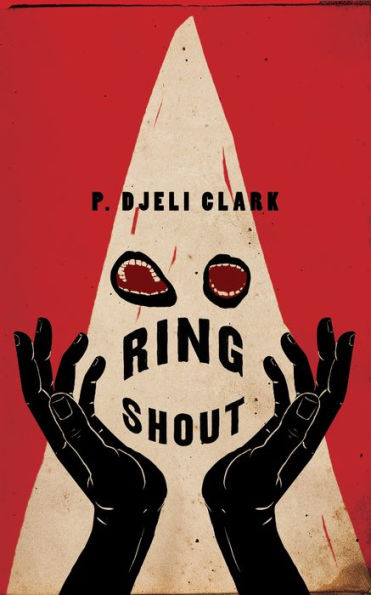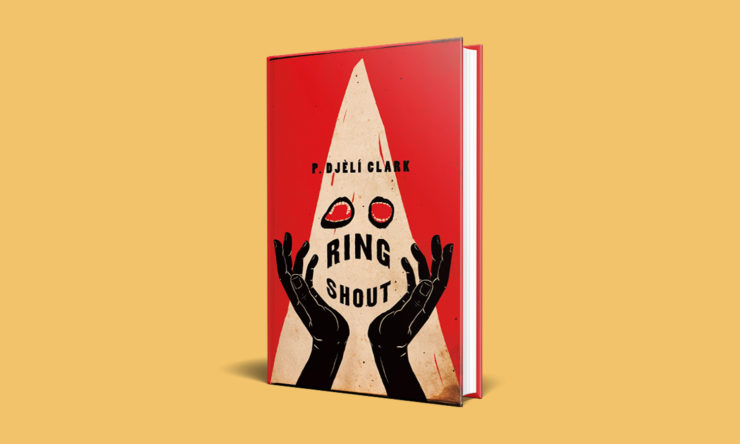Ring Shout, the latest historical fantasy novella by the ever-brilliant P. Djèlí Clark, achieves what the TV show Lovecraft Country couldn’t manage: to do something entirely new with H.P. Lovecraft. Twisting and twining racial violence with supernatural horror is old hat, but Clark has never been an author to settle for what’s expected.
It’s 1922 and the Ku Klux Klan is back in action, this time with some help from the supernatural. Maryse Boudreaux and her crew are the only thing keeping the monsters (chthonic creatures, called Ku Kluxes, from another dimension that possess their human host) and the human but equally as awful racists (called Klans) in check. Years before, Maryse’s entire family was slaughtered by Ku Kluxes. She was gifted a magical sword imbued with the spirits of those who sold her ancestors into slavery, and she uses it to execute every Ku Klux she can get her hands on. Aiding her in her righteous war is Sadie, the smart-mouthed hellion who can outshoot a world-class sniper, Cordelia, aka Chef, an explosives expert and war vet who channels her trauma into dismantling systems of oppression, and Nana Jean, the leader of a magical Ring Shout group.
Something big is coming. There are more and more Ku Kluxes every day. Butcher Clyde, a giant of a man who is more than what he appears, is involved, that’s for certain. Less so is how… and why. Whatever is going on, it’s going to happen soon at Stone Mountain. The demons are multiplying and time is running out.
Buy the Book


Ring Shout
Importantly, Clark emphasizes the monstrousness of the KKK without minimizing the evil done by the humans. In his world, Ku Kluxes are demons and the Klan are humans, but the two work together, even if the humans don’t realize it until it’s too late. Evil isn’t always monsters and demons and an uncontrolled thirst for power. Sometimes it’s regular people standing aside to let terrible things happen. Sometimes it’s regular people standing behind the monsters cheering in support. Sometimes it’s an otherworldly creature of inexplicable horror and sometimes it’s a white woman glaring at a Black woman for having the audacity to exist in her general vicinity.
Too often we think of the KKK as a posse of men in white hoods riding around on horses and terrorizing Southern Black folks. But they weren’t limited to the Deep South. The Klan was as much in urban areas as much as rural. Middle of nowhere, small towns, big cities, major metropolises. Friends and neighbors, wives and mothers, classmates, churchgoers, teachers, saloonkeepers, bankers. The rich, the poor, and the growing middle class. By 1924, the KKK had an estimated 1.5-4 million members coast to coast. Politicians from both parties, governors, senators, congressmen, secretaries of state, mayors, city councilmen, even a supreme court justice.
Stone Mountain wasn’t chosen haphazardly by Clark. William Joseph Simmons was so inspired by Birth of a Nation, D. W. Griffith’s film about a band of white men donned in crisp white Klan robes who rescue a white woman from “savage” African American men (white men in blackface), that he used it as the basis to restart the Ku Klux Klan. Shortly before the film was set to premiere in Atlanta in 1915, Simmons held a small rally at Stone Mountain where they read Bible verses and burned a cross. Every Labor Day for the next half century, the KKK held a cross burning there to celebrate. The year before Simmons, the Atlanta Constitution published an editorial suggesting Stone Mountain as the site for a Confederate memorial. This wasn’t the first suggestion, nor was it the last. Fundraising efforts by members of the KKK and the United Daughters of the Confederacy started and stopped for years. It took until the start of the Civil Rights Movement in the 1950s before white Southerners finally took over the area and carved the faces of Jefferson Davis, Robert E. Lee, and Stonewall Jackson into the rock. Clark didn’t make Stone Mountain a site of a major racist event for the sake of his story; it already was one.
Tweaking the real history by adding magic is a clever idea, one that works so well precisely because the fantasy is rooted in truth. Birth of a Nation breathed life into an organization on the edge of death. The film gave white people permission to be publicly racist. Clark grafted interdimensional demons onto the movie by having them feed on the hate the film inspired, but the hate itself was all real.
Choosing to parallel Klan rallies with ring shouts is genius-level work on Clark’s part. Many people know about Birth of a Nation, but few know about ring shouts. It is a West African tradition brought to the New World by enslaved people where people sing songs with typically Christian themes while moving in a circle. The tradition is still common in the Gullah-Geechee community in particular, but the bones of the call-and-response, stomping and clamping, and beat can be found in everything from jazz to blues to rock ‘n’ roll. The ring shout is an act of unity and resistance. It is a way to commune with ancestors and worship with kin. With the rallies, we see white people pooling their collective hate to summon monsters from another world. With ring shouts, however, we see Black people pooling their love and respect to ask the ancestors for guidance and assistance. One is a force for destruction, the other of creation. One drains and corrupts, the other blesses and empowers.
Each book from P. Djèlí Clark is better than the last. And that’s saying something when they are all absolutely fantastic. Ring Shout is exactly what I wanted from Clark doing cosmic horror in a historical fantasy setting. It is simultaneously unrelenting, eviscerating, and unflinching. There is no one quite like P. Djèlí Clark and no story like Ring Shout. Get this book in your hands immediately.
Ring Shout is available from Tordotcom Publishing.
Read an excerpt here.
Alex Brown is a librarian by day, local historian by night, author and writer by passion, and an ace/aro Black woman all the time. Keep up with her on Twitter, Instagram, and her blog.










